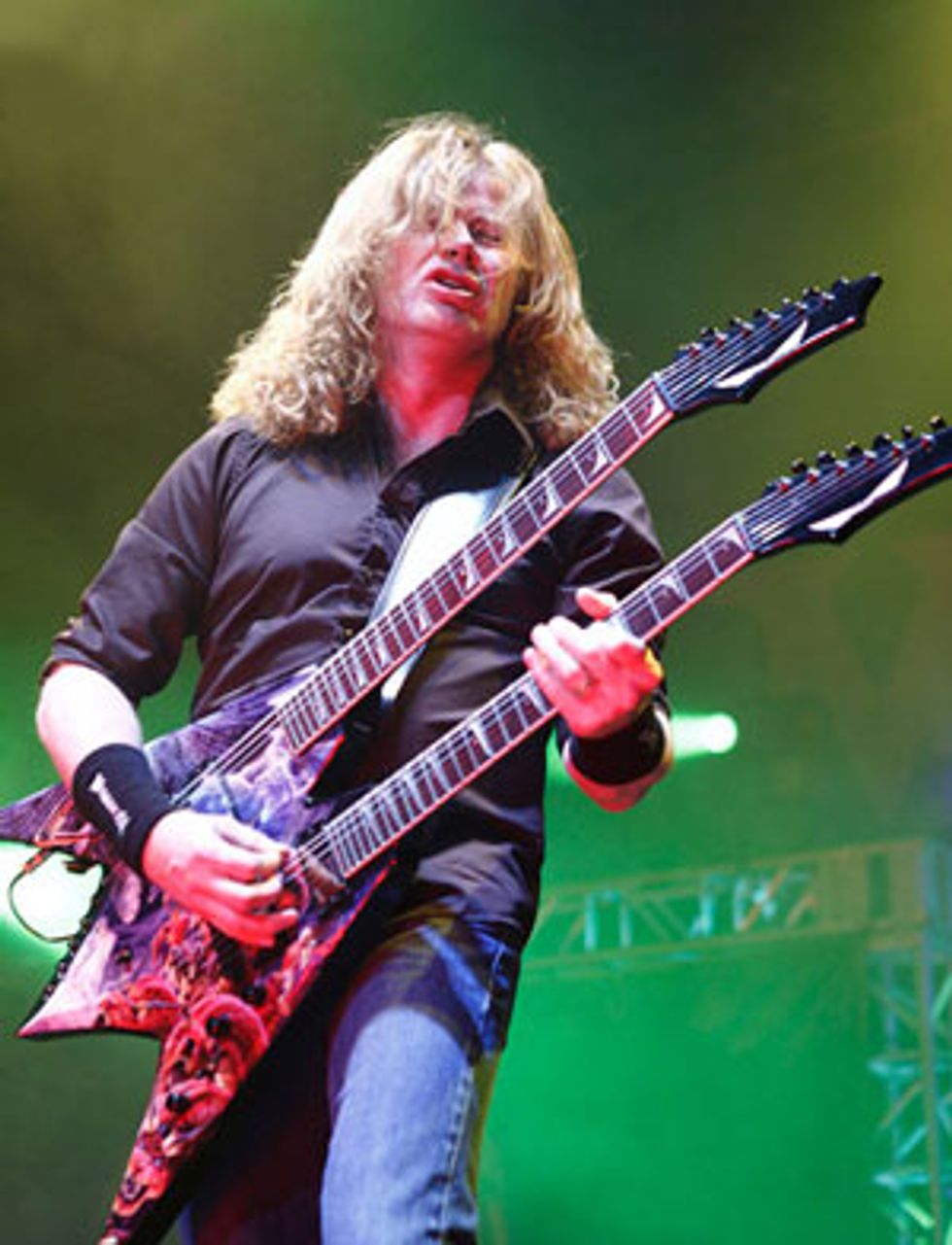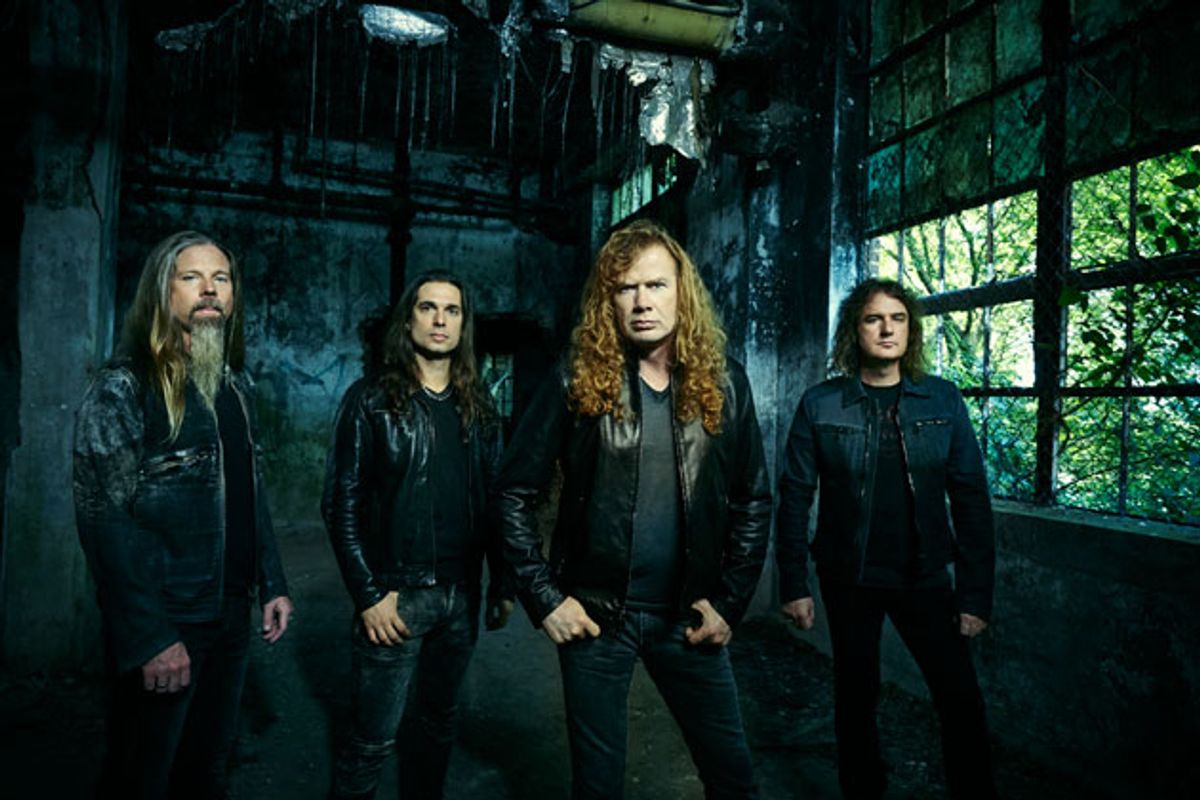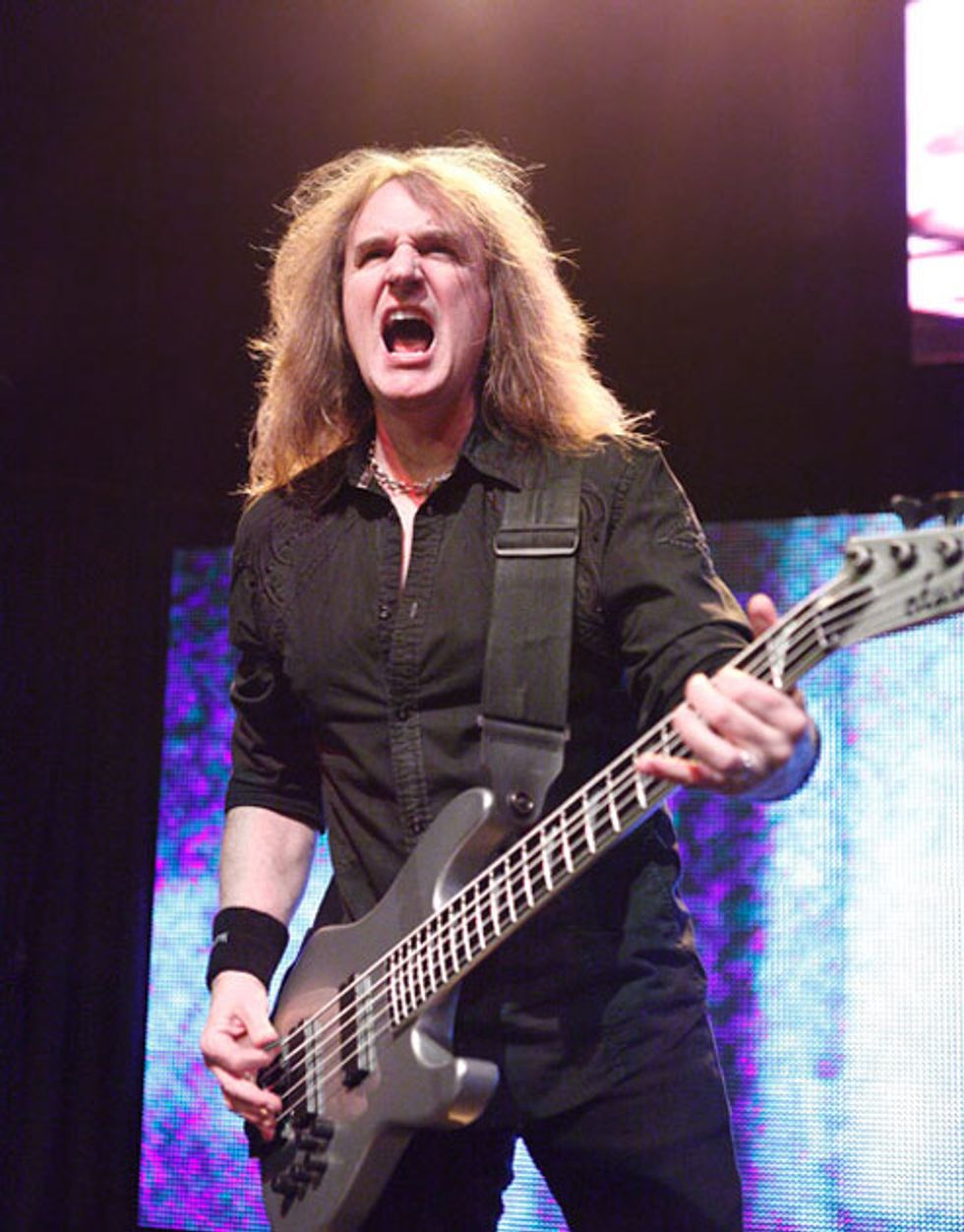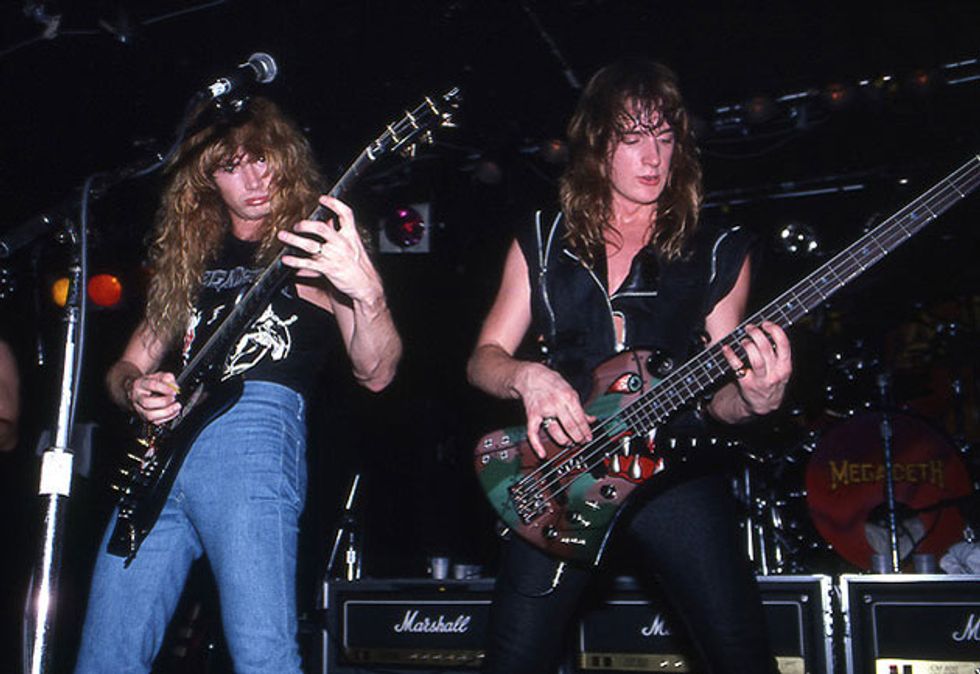The thrash metal pioneers plot world conquest via Dystopia, an edgy new album that revisits the band’s roaring roots while showcasing the blazing Kiko Loureiro on guitar.
“I like painting,” says Dave Mustaine, “but I’m probably more partial to sculpture. And I can find a lot of majesty in great architecture. I think that’s really helpful when you’re writing music.”
Calling in from a tour stop in India, the Megadeth frontman, guitarist, cofounder, and all around mastermind has just broken off from a story about the band’s 15th studio album, Dystopia, to answer one of those obligatory interview questions about art and musical influences. And after more than an hour of conversation with him and Megadeth cofounder and bassist David “Junior” Ellefson, it’s easy to see the connection between stone, steel, and the thundering riffs that hold together this towering follow-up to 2013’s Super Collider.
That album sold well, debuting at No. 6 on Billboard’s albums chart, but got a lukewarm reception from critics and some longtime fans. Now, the driving power of Dystopia presents a band on a mission—a unit with a renewed sense of purpose and, thanks to a new line-up, fresh cohesion.
The sound they’ve constructed stands as a monument to Megadeth’s status as one of thrash metal’s iconic outfits, delivered with a fury that harkens back to the band’s roots and a finesse that shows that a group can mature and still rock like a pile driver. The album’s 13 songs are built, as always, on the spine of Mustaine’s rhythm playing and riveted in place by Ellefson’s steam hammer bass, and then spiked into the stratosphere by the fleet, melodic attack of new addition Kiko Loureiro, who was formerly lead guitarist in the Brazilian metal band Angra. He replaced Chris Broderick, who ended his six-year tenure in November 2014. And Mustaine’s pointed lyrics continue to illuminate the world’s dark corners, wherever they’re found—the boardroom, the killing fields, the White House, or the human heart.
Dystopia may not precisely be a “comeback,” but, as Ellefson puts it, “a year ago, Megadeth was in a very different place.”
—Dave Mustaine
Actually, the band has been in many “different places” over the years. In the aftermath of Mustaine’s departure from Metallica in 1983, he connected with Ellefson in Los Angeles and refined the template for thrash metal. After the band’s opening salvo—the indie release Killing Is My Business… and Business Is Good!—Megadeth’s combination of speed, power, and attitude would lead to a major label deal, a rapid flight to the summit of the metal world, and, eventually, gain the group a foothold among mainstream rock fans as well.
No one would call it a smooth ride. Always marked by lineup changes, Megadeth dealt with personnel issues that eventually reached the band’s core in the early 2000s, when a feud between Ellefson and Mustaine triggered the bassist’s departure. Megadeth rebounded with one of its most successful albums, 2004’s The System Has Failed, while Ellefson formed the band F5 and, later, joined Avian, recorded with Soulfly, and kept busy with a range of other musical projects.
By the end of the decade, the relationship between the two Daves had thawed to the point that Ellefson rejoined for 2011’s TH1RT3EN, his first album with the group since 2001’s The World Needs a Hero. At the time, Mustaine said the album captured the “proudest moments of my musical career.” The partnership between the two thrash metal architects has remained solid ever since.
Dystopia was recorded in Nashville with Mustaine, who recently relocated to Tennessee, in the producer’s chair along with Alice in Chains and Slayer producer Toby Wright. Besides the two Daves and Loureiro, the new crew also includes drummer Chris Adler, on holiday from Lamb of God. Shawn Drover, who spent a decade behind the kit in Megadeth, joined Broderick to form their own new band, Act of Defiance. The current, rejuvenated Megadeth line-up will kick off a North American tour in February.
When I began our interview by asking about the goals for Megadeth’s latest incarnation, Mustaine replied, “I’m very excited about the lineup change. And our goal is to rule the world.”

Sometimes two headstocks are better than one, and that’s when Dave Mustaine whips out his Dean V Double Neck Diadem, equipped with Seymour Duncan Live Wire pickups. Only 75 examples of this signature model guitar were built. Photo by Ken Settle
How’s the transition into the new line-up been so far?
Mustaine: Actually, we never played together in the same room prior to being on tour. And that, to me, is just mind-boggling. It reminds me of some of the baby bands I was in when you’ve got, like, six rehearsals together and you’re out headlining festivals.
How did the material for Dystopia come together?
Mustaine: Much like any other Megadeth record, the songs have pieces that I’ve written [over time]. I write in segments. Some of the songs on this record were written in the studio, but with some of the songs, parts were written as far back as 30-plus years ago.
I’ve only written a complete song from beginning to end a couple of times. The first was “In My Darkest Hour” from 1988’s So Far, So Good… So What!, when Cliff [Burton, Metallica’s bassist] died. I was so heartbroken that I went and got a guitar and wrote the song. The other time was “Use the Man” [from 1997’s Cryptic Writings]—the same kind of process. Something traumatic had happened and I wrote the song from beginning to end.
Some have called this album a return to your glory days. Do you buy that?
Mustaine: I liked a lot of the music we wrote in the 1980s and very early ’90s. I thought we were really able to assemble melody and heaviness and pull it off. The song “Dystopia” reminds me a lot of stuff that was on [1990’s] Rust in Peace—really in-your-face, ripping stuff where each segment would dovetail into the next, and have these remarkable scenes in between. There’ll be a part playing and it will go into the next part and you’ll be saying, “These two parts don’t go together at all, but, boy, they sure fit well [laughs].”
Do you start with the guitar, or do you write in your head and then figure it out?
Mustaine: Well, I’m self-taught so I don’t really know how to play formally. I don’t like practicing either. I’m the kind of guy that, when I pick up a guitar and start playing, I’m trying something new all the time. I don’t go over scales or runs. It usually comes in bits and pieces—like making a puzzle, I guess, or adding one piece of track after another on a train track.
When a song is done, I like being able to sit with it for a little while and go back and fix it. We had that luxury on this record and we haven’t had that for quite a while. Ellefson refreshed my memory about that and said, “You know, bro, it’s nice not to have to go in there between breaks in touring and say, ‘You’ve got two months off now—get in there and make a fuckin’ record [laughs].’” I love our label [Universal] right now!
Dave Mustaine calls David Ellefson Megadeth’s “shepherd,” praising his ability to keep the group focused onstage and inspire lightning-strike performances. Photo by Ken Settle
How did the arrangements evolve?
Mustaine: The songs told us what they wanted. It’s something I haven’t experienced in a very long time. Ellefson came out to Leipers Fork [Tennessee], and I said, “We’ve got all the songs written already, let me show them to you real quick.” We had tried to do some of them when I was living in Cali before I moved out to Tennessee. We actually recorded all the bass parts first.
Ellefson: It was an interesting process. I don’t know of any other record that started with recording the bass to a click track [laughs]. I’d worked with Dave on some demos almost a year earlier. We started putting bass parts down, going back and forth with some ideas, and then watching those songs develop, and hearing those developments when they were happening. When Chris and Kiko came into the group, things moved very quickly to a whole other level. By the time I was in carving bass parts, this juggernaut was taking off and it’s been incredible to see the arrangements were definitely there.
Was recording that way a challenge?
Ellefson: In Megadeth, the drums and Dave’s rhythm guitar have always defined not only the structure of the song, but also the notation of the riff. In the studio, at least I’d have that framework—the two building blocks. I could be the mortar between the bricks and glue things together.
Dave Mustaine’s Gear
GuitarsDean Dave Mustaine VMNT SVB
Dean Dave Mustaine VMNT Korina Limited
Dean Dave Mustaine Zero XO
Dean V Dave Mustaine Angel of Death
Dean V Dave Mustaine Double Neck Diadem
Dean Dave Mustaine Mako acoustic
Amps
Marshall JVM410H
Marshall JCM 800 Randy Rhoads model
Fractal Axe-Fx II
Marshall 1960BV Dave Mustaine 4x12 Signature cabs with G12 Vintage 30s
Marshall EL34 100/100 Dual Monobloc Power Amps
Effects
XTS Precision Multi-Drive
Xotic Effects BB Preamp
Boss SD-1 OverDrive
TWA Triskelion 2.0 Harmonic Energizer
Furman PL Plus DMC power conditioner
Radial JDX 48 guitar amp direct box
Rocktron All Access MIDI controller
Rocktron HUSH Pro noise reduction unit
Furman PL Plus power conditioner
Whirlwind 4-channel MultiSelector
Shure UHF-R wireless system
Shure UA845 antenna combiner
Shure UA870WB paddle antennas
Strings and Picks
Cleartone customs (.010–.052 for standard tuning, .011–.054 for D tuning)
Cleartone .73 mm
David Ellefson’s Gear
BassesJackson USA Custom Shop David Ellefson Rust in Peace 20th Anniversary LTD 5-string
Jackson USA Custom Shop David Ellefson Signature Concert 5-string
Jackson David Ellefson Signature Kelly Bird V 5-string
Jackson David Ellefson Signature Kelly Bird 4-string
Amps
Hartke LH1000 with Hartke 210XL cab
Hartke LH1000 with Hartke HyDrive HX810 cab
Ampeg SVT CL with Ampeg SVT-810 cab
Effects
Hartke Bass Attack VXL Tone-Shaper preamp
Providence DBS-1 Dual Bass Station preamp
Providence ADC-4 Anadime Bass Chorus
ISP Technologies Beta Bass preamp
Peterson VS-R StroboRack Virtual Strobe rack tuner
Shure UHF-R wireless system
Radial Passive Direct Box
Whirlwind 4-channel MultiSelector
Shure UHF-R wireless system
Shure UA845 antenna combiner
Shure UA870WB paddle antennas
Strings and Picks
SIT David Ellefson Signature Series 5-string (.045–.128) and 4-string (.045–.105) sets
Dunlop Tortex .88 mm
How did you get the feel without the guitar and drums as a guide?
Mustaine: Fortunately, Ellefson has great swing to his playing. And he and I have a really amazing relationship when it comes down to me vociferating a guitar part. He’s always played with an approach we’ve tried to take, which is that he plays lead bass.
Ellefson: A lot of it speaks to the fact that me and Dave intuitively know how each other plays and know how a Megadeth record should sound, and how the bass should go—the tone, the parts, the style, the picking and notation. Out of 15 Megadeth studio albums, I’ve done 12.
You mentioned earlier that the making of Dystopia reminded you of the band’s early days. How so?
Ellefson: Keep in mind that Dave and I were essentially homeless and would squat in people’s homes to have a place to live in 1983 through ’84 and into ’85, when we were putting together Killing Is My Business and Peace Sells. It was always rhythm guitar and bass—that was the foundation. So fast-forward 30 years later and here we are sitting in a studio in Nashville and it felt very much like me and Dave sitting in someone’s apartment in 1983—Dave with his B.C. Rich Bich playing through [his] little Peavey amp, and me with my B.C. Rich Mockingbird bass into my little Roland Cube bass amp that I brought with me from Minnesota. That’s how we composed the first two Megadeth records.
How did the guitars on Dystopia go down, and what was it like working with Kiko?
Ellefson: Dave would sit and work with Kiko, playing rhythm guitar, which was very different, because normally Dave would have his rhythms down [first]. That is “true north.” So for Dave to spend time putting rhythms down with Kiko shows Kiko’s incredible musicianship. His playing seems effortless. I’m always amazed by his ability to hear Dave play something, quickly learn it, and then never forget it. I haven’t seen somebody do rhythm guitar in Megadeth that well probably since Kerry King was playing with us in ’84. It was amazing—and we’re not even talking about his lead guitar abilities!
Speaking of lead guitar, Dave, what’s your approach to soloing as a player and as a writer/producer?
Mustaine: When you live, breathe, and feel the song that you’re writing, the song pretty much tells you what it needs. I’m not a believer that a solo
has to be shredding with a wang bar, though I
think a lot of people do some really great work with that. I’m of the belief that a player like David Gilmour could do more with one note than some of today’s shredders can do with a dozen. On some of these solos that are ripping fast, you just hear rrrrrrrrrr. It’s like, “Man, come on!”
Ellefson: Remember, the rhythm guitars in Megadeth are as complex as most lead guitar solos. Not just the notes, but the nuances, the
push and the pull, sliding into notes, sliding out of notes, the hammer-on/pull-off thing, and, most importantly, the right hand. That’s where the signature sound comes from. When you join Megadeth, like Kiko did, to be able to really understand the signature sound of the band—what Dave and I pioneered so many years ago—is knowing that it isn’t just the left hand. It’s really about how you execute the notes, picking with the right hand.
In the ’80s, Brooklyn’s L’Amour was the place for up-and-coming metal bands to show their goods. Here, Dave Mustaine and David Ellefson rock out on the club’s stage in front of a modest wall of Marshalls in 1987. Photo by Frank White
The songs on Dystopia sound like vintage Megadeth. What stands out for you?
Ellefson: “Fatal Illusion” really brings forward a part of Megadeth that people haven’t heard in many, many years—both musically and lyrically. I like “The Threat Is Real” and “Post American World”—especially how the riff in it reminds me of when we were working on the earliest Megadeth, like “Set the World Afire” [from So Far, So Good… So What!] and “Devils Island” [from Peace Sells… but Who’s Buying?]. It has this really slow groove before we speed it up—these really chunky, scary sounding riffs.
“The Threat Is Real” starts the album with a surprising Middle Eastern vocal part before the riff takes over. How did that come about?
Mustaine: I had gone to a spiritual event by someone who was mentoring me—a very successful, intelligent guy who’s aware, to a degree, of what we have to go through as men to be troubadours if we want to be successful in our married lives. While I was there, he said, “I have this really strange feeling you’re going to do some very strong and necessary healing between the West and the Middle East through music, and I was like... “Whaaat?!”
Then the opportunity came up for us to do “Poisonous Shadows” [another Dystopia track], and I wanted it to have a really cool kind of vibe. Farah Siraj, a vocalist from Jordan who’s the country’s ambassador of music, initially came out to sing with this “Kashmir” kind of vibe. And it was so great. After we heard her performance, we were like, “Let’s get her to do some kind of ambience at the beginning of ‘The Threat Is Real.’” The song is super heavy, especially in the breakdown in the middle under the solo.
David, from a bass playing standpoint, what are your favorite moments?
Ellefson: I love things that are really bombastic, like “Poisonous Shadows” and “Dystopia”—things that don’t necessarily have to be super complex, where the bass creates this really big, supportive sound. The bass performs two roles in Megadeth. One is this really big supportive sound that started back in the 1990s with Countdown to Extinction, Youthanasia, and Cryptic Writings. Then there’s also the moment where it comes out and kicks you in the teeth, and I think we’ve got the best of those in Dystopia.
That’s apparent on the first single, “Fatal Illusion.”
Ellefson: I’m glad that is the first bass part people got to hear on the record. That’s what people want to hear from Megadeth—these mind-blowing bass breaks that just step out and smack you in the face and hurt [laughs].
Is it different working together now verses when you were younger?
Ellefson: My experiences away from Megadeth have made me a much better Megadeth bass player. The years when I wasn’t working with Dave, he had a chance to run the show on his own, and that’s an entirely different experience. I’ve seen him grow more in the last several years than in many of the years before, because it all rested on his shoulders and he really rose to the occasion. He has become adept at Pro Tools, and for this record I feel that Dave really, truly was the producer.
When I went to L.A. [in the early 1980s], I was confident in my abilities. I just needed to find the right channel to direct them into. And Dave is probably one of the most confident people I’ve ever met in my life [laughs]. He’s been that way since the day I met him when he was 21. Which is why I became this blank canvas for him that he could mold and shape around his music. It’s the reason I’ve been able to be here the longest. I was there the day the vision was being cast. It’s a different place to start from. There are times when I’m able to create things that are right for the song and there are other times when I think, “This is what Dave needs.” And I’m able to get behind that.
YouTube It
Farah Siraj’s keening voice adds mystery to the opening of “The Threat is Real” from Megadeth’s Dystopia. In this animated video, prisoners struggle against a totalitarian regime in a bleak, hyper-violent world as the band delivers its high-velocity riffage and warp-speed solos.
I prefer now to the early days—yet in the early days of your career, you’re really starting with a piece of clay that you can do anything with. That’s a really fun part of your career: creating something that’s never been created before.
I’ve always said Dave is the founder of thrash metal. It’s almost like he took Diamond Head songs and played them really fast and brash, almost to the point of out of control. That’s what created what really is thrash metal. And to be part of that mission from the very beginning is such a cool contribution.
Mustaine: I joke around, calling David the “keeper of the facts.” He’s like the band’s ambassador because he’s a really well-mannered, well-meaning kind of guy. Whereas my head is always focusing on what our goals are, which is, you know, really seriously being the biggest band in the world. I mean, who would set out to do anything without the desire to be the absolute best at it?
Dave’s able to be kind of like a shepherd onstage. When I’ve got my back turned and I’m singing into a microphone, or I’m playing a guitar solo way on the other side of the stage, he and Kiko have that time where they can really work together. This is genuinely the best we’ve ever gotten along, and we’re getting tighter and as cohesive as possible onstage. Standing next to each other and doing the Kiss guitar moves—I’m sure that will come at some point. But the most important thing right now is just being able to play together and let people see how much we enjoy making music together.


